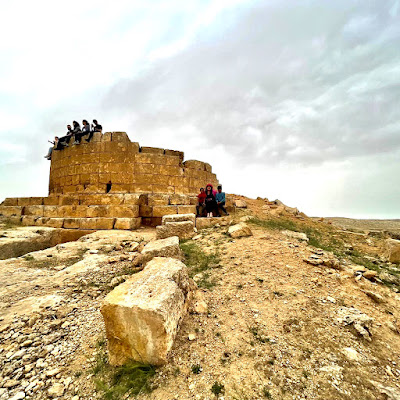People usually go to watch either a sunrise or sunset at Nemrut Mountain. We made it for the most spectacular sunset. The summit is only 600 meters (2000 ft) hike from the parking lot but it's quite steep.I was breathless. This highest peak (2134 meters/7000 ft) of Eastern Taurus mountain range is close to Adiyaman. A Unesco World Heritage site, Nemrut is a tomb and house for Gods and Goddesses built by King Antiochos I of Commagene (69-34 B.C.).
Commagene claims to bring East and West together and this is where I truly felt it. Commagene King carry Persian ancestors, from paternal site (a descendant of Darius by his father Mithridates) and Macedonian ancestors from maternal side (descendant of Alexander the Great by his mother Laodice).Another uniqueness is the assimilation of Eastern and Western Gods: Five giant seated limestone statues awaits you: Antiochus himself, the goddess of Commagene, Zeus-Orosmasdes-Ahura Mazda, Apollo-Mithras-Helios-Hermes, and Artagnes-Bahram-Heracles-Ares.
Unfortunately, the world’s first horoscope is not in display, locked away from sight. This doesn’t change the mystical experience.
Harran
Harran, an ancient city and trade center in northern Mesopotamia, is also known for the traditional beehive houses.. Only a few hundred of Harran's beehive houses are left but the good news is they are under the protection and are being restored for touristic purposes.
This style is an architectural tradition in this area for at least 3,000 years. Covered with mud or clay, the mortar of the buildings were made from rose leaves, straw, soil and egg whites. they fence off heat during hot summers (up to 50 C/125 F) and retain cool air.
 |
| Traditional Harran Houses |
Harran is also famous for the Sin temple dedicated to Sin, the Moon God.
The Moon God plays an important role in the Babylonian and Assyrian religions, and was first known as the chief god of the Ur city, and later became the most important god of Harran.
The Sin/Moon temple was established sometime at the end of the Neo-Sumerian Empire (circa 2000 BCE).
 |
| Harran=Sin Temple |
Sogmatar
Sogmatar was the highlight of our Anatolian trip for me. If I could describe my experience in the Sogmatar temple in one word it would be non-duality.
If you expect to see fancy ruins, towers or temples, you’ll be highly disappointed in Sogmatar. In fact, there is almost nothing visible immediately when you get to Sogmatar. Soğmatar was a pagan religious center and dates back to the 2nd century. Close to Harran, south of Urfa, it is also known as the Town of Seven Temples, as the people of Harran worshiped the moon and planetary gods.
Here is an article I wrote about Sogmatar, if you want to read more…
https://reikinewsletter.blogspot.com/2022/08/
 |
| Sogmatar |
Resources and Thanks:
Konya and Catalhoyuk
Mayda Travel- Ibrahim Mayda
Tel: +90 507 7918077
Professional Tour Guide Ilker Yaglier
Ankara and Hattusas
Bizim Ada Tourism
www.bizimada.com.tr
Yasin Bey + 90 546 4183800
Professional Tour guide: Senem Guzel
Mardin
Seker Rent-a-Car
Gokhan Bey +90-542-5303155
Diyarbakir
Asur Turizm
Dogan San
0(412) 235 02 22
http://www.asurturizm.com.tr/?i89/iletisim.html
Via Maris Turizm
Neslisah Cevahir
Special Thanks to: Gokturk Ramu, Halit Aygat, Ates Shaman
For self guided tours, you can follow:
https://www.birhayalinpesinde.com/turkiye



No comments:
Post a Comment